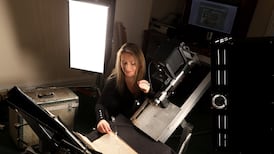I confess to a soft spot for dystopian science fiction. Some of my favourite imagined futures include the world paralysed by a giant, perpetual traffic jam (Strange Travellers by Gene Wolfe) and the apocalypse brought on by the disintegration of the moon (Seveneves by Neal Stephenson). The latter scenario unfolded so slowly that the world had time to greatly modify the International Space Station for long-term existence and launch members of the future human race into space. These are relatively recent examples, but literature has had a long engagement with science. Fiction enables us to imagine not only future scientific advances but to consider how they might interact with society and individuals, altering the moral world alongside the physical one. So how have science fiction writers done in predicting the future?
Human imagination
It's easy to think of examples that pervade science fiction yet have not made it into our everyday. For some reason, the future suggests to the human imagination a forsaking of earthbound transportation. HG Wells was only one among many writers to predict a time machine. Jules Verne imagined not only a submarine (already in exploratory development during the 19th century) but a rocket launcher to bring humans to the moon. The presence of hoverboards (Back to the Future), jetpacks (Thunderball) or flying cars (Blade Runner) is enough to signal in a film that the viewer has arrived in "the future". Add androids for good measure.
Jetpacks or "personal propulsion devices" do appear to be getting nearer, with the Martin Jetpack company in the final stages of testing. The jetpack is initially envisioned for emergency response situations and requires considerable technical knowledge to fly, but the website promises a move to personal jetpacks if those used for rescue prove successful. The recent trend for hoverboards involved decidedly earthbound, and decidedly flawed, vehicles. Flying cars don't fit terribly well with an overloaded air-traffic-control system or with attempts to reduce fossil fuel use. Robotics and artificial intelligence have made huge strides but a race of androids still seems distant.
Reams of information
Some writers have hit closer to the mark. William Gibson, for example, popularised the term "cyberspace" in his 1984 novel Neuromancer. He had himself coined the term in a previous work. He has even been credited with shaping the internet by his vision of computer communication put forward in the novel. In the Hitchhiker's Guide to the Galaxy (Douglas Adams), the guide itself resembled an iPad. Ray Bradbury's Fahrenheit 451 has an extremely evocative image of watching TV walls, now to be found in every household in the form of a flatscreen. In 1984, George Orwell introduced the "telescreen" that Winston thought he was watching but which was actually watching him. Now we have social media and our phones which, although not watching us with eyes, are busily recording reams of information about our everyday activities.
Predictions of biological technologies have also occasionally proved prescient. HG Wells's Island of Dr Moreau chronicled the production of human-animal hybrids by the corrupt and cruel Dr Moreau. In Wells's account, these hybrids were created via vivisection yet scientists are quite seriously trying to figure out how to use laboratory animals to grow human tissues. More recently, Margaret Atwood's Oryx and Crake predicted a move towards synthetic meat. In the novel, ChickieNobs, chicken meat grown on the ends of sticks, have replaced actual chickens.
Technology and morality
What all these predictions share, of course, is a timeless concern with whether technology is a force for good or evil. Bradbury's dystopian society of book-burners watching mind-numbing TV walls was a reaction to McCarthy-era America, but still resonates in the world of ever-present screens broadcasting endless cute cat videos. Yet science and technology also clearly appeal to writers because, like writing, they are intensely creative. Perhaps a bit of science fiction in the school curriculum would not go amiss.
If you want to hear a more in-depth talk on the history of the future, I invite you to join me at the HSTM Network Ireland conference this week at Dublin City University. In his keynote address, Peter Bowler will look at predictions about science and technology in 19th- and 20th-century fiction. See hstmnetworkireland.org for details.
Special thanks to Martin Fanning for his superior sci-fi knowledge. Juliana Adelman lectures in history at Dublin City University










